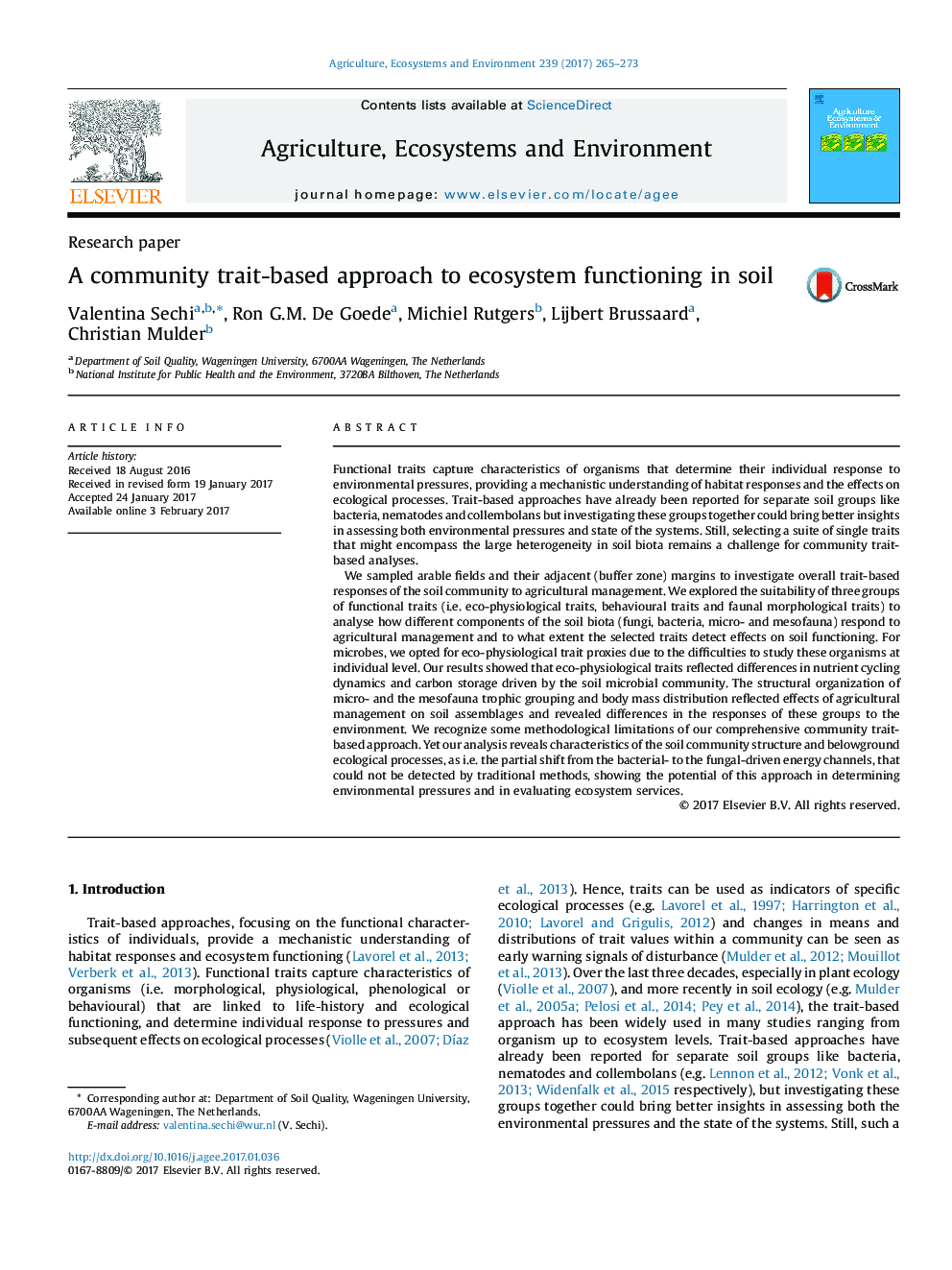| کد مقاله | کد نشریه | سال انتشار | مقاله انگلیسی | نسخه تمام متن |
|---|---|---|---|---|
| 5537933 | 1552013 | 2017 | 9 صفحه PDF | دانلود رایگان |
عنوان انگلیسی مقاله ISI
A community trait-based approach to ecosystem functioning in soil
ترجمه فارسی عنوان
یک رویکرد مبتنی بر جامعه به عملکرد اکوسیستم در خاک
دانلود مقاله + سفارش ترجمه
دانلود مقاله ISI انگلیسی
رایگان برای ایرانیان
کلمات کلیدی
مدیریت کشاورزی، جرم بدن، صفات زیستشناختی، پاسخ عملکردی، زمین بی مهرگان، تغذیه صنفی،
ترجمه چکیده
ما مناطق حاشیه ای و مناطق مجاور آن (منطقه بافر) را برای بررسی کلیه واکنش های مبتنی بر صفات جامعه خاکی به مدیریت کشاورزی، مورد مطالعه قرار دادیم. ما در بررسی مناسب بودن سه گروه از صفات عملکردی (به عنوان مثال صفات زیست شناختی، صفات رفتاری و صفات مورفولوژیکی فون) بررسی شد که چگونه اجزای مختلف زیست توده خاک (قارچ ها، باکتری ها، میکرو و ماسفونا) به مدیریت کشاورزی پاسخ می دهند و چه چیزی اندازه گیری صفات انتخاب شده اثرات را بر عملکرد خاک بررسی می کند. برای میکروب ها، ما به دلیل مشکلاتی که برای مطالعه این ارگانیسم ها در سطح فردی انجام دادیم، پروکسی صفت فیزیولوژیکی را انتخاب کردیم. نتایج ما نشان داد که صفات زیست محیطی و فیزیولوژیکی تفاوت های موجود در پویایی دوچرخه سواری مواد مغذی و ذخایر کربن را که توسط جامعه میکروبی خاک رانده می شود، منعکس می کند. سازماندهی ساختاری گروه بندی تروفیک میکرو و مسیفونا و توزیع توده بدن، اثرات مدیریت کشاورزی بر روی سازه های خاک را نشان می دهد و تفاوت های پاسخ های این گروه ها را به محیط نشان می دهد. ما برخی از محدودیت های روش شناختی رویکرد مبتنی بر رویکرد جامع جامعه ما را تشخیص می دهیم. با این وجود، تجزیه و تحلیل ما نشان می دهد ویژگی های ساختار جامعه خاک و فرآیندهای زیست محیطی زیر زمین، به عنوان مثال تغییر جزئی از کانال های انرژی باکتریایی به قارچ، که نمی تواند با روش های سنتی شناسایی شود، نشان دهنده پتانسیل این روش در تعیین محیط زیست فشار و ارزیابی خدمات اکوسیستم.
موضوعات مرتبط
علوم زیستی و بیوفناوری
علوم کشاورزی و بیولوژیک
علوم زراعت و اصلاح نباتات
چکیده انگلیسی
We sampled arable fields and their adjacent (buffer zone) margins to investigate overall trait-based responses of the soil community to agricultural management. We explored the suitability of three groups of functional traits (i.e. eco-physiological traits, behavioural traits and faunal morphological traits) to analyse how different components of the soil biota (fungi, bacteria, micro- and mesofauna) respond to agricultural management and to what extent the selected traits detect effects on soil functioning. For microbes, we opted for eco-physiological trait proxies due to the difficulties to study these organisms at individual level. Our results showed that eco-physiological traits reflected differences in nutrient cycling dynamics and carbon storage driven by the soil microbial community. The structural organization of micro- and the mesofauna trophic grouping and body mass distribution reflected effects of agricultural management on soil assemblages and revealed differences in the responses of these groups to the environment. We recognize some methodological limitations of our comprehensive community trait-based approach. Yet our analysis reveals characteristics of the soil community structure and belowground ecological processes, as i.e. the partial shift from the bacterial- to the fungal-driven energy channels, that could not be detected by traditional methods, showing the potential of this approach in determining environmental pressures and in evaluating ecosystem services.
ناشر
Database: Elsevier - ScienceDirect (ساینس دایرکت)
Journal: Agriculture, Ecosystems & Environment - Volume 239, 15 February 2017, Pages 265-273
Journal: Agriculture, Ecosystems & Environment - Volume 239, 15 February 2017, Pages 265-273
نویسندگان
Valentina Sechi, Ron G.M. De Goede, Michiel Rutgers, Lijbert Brussaard, Christian Mulder,
